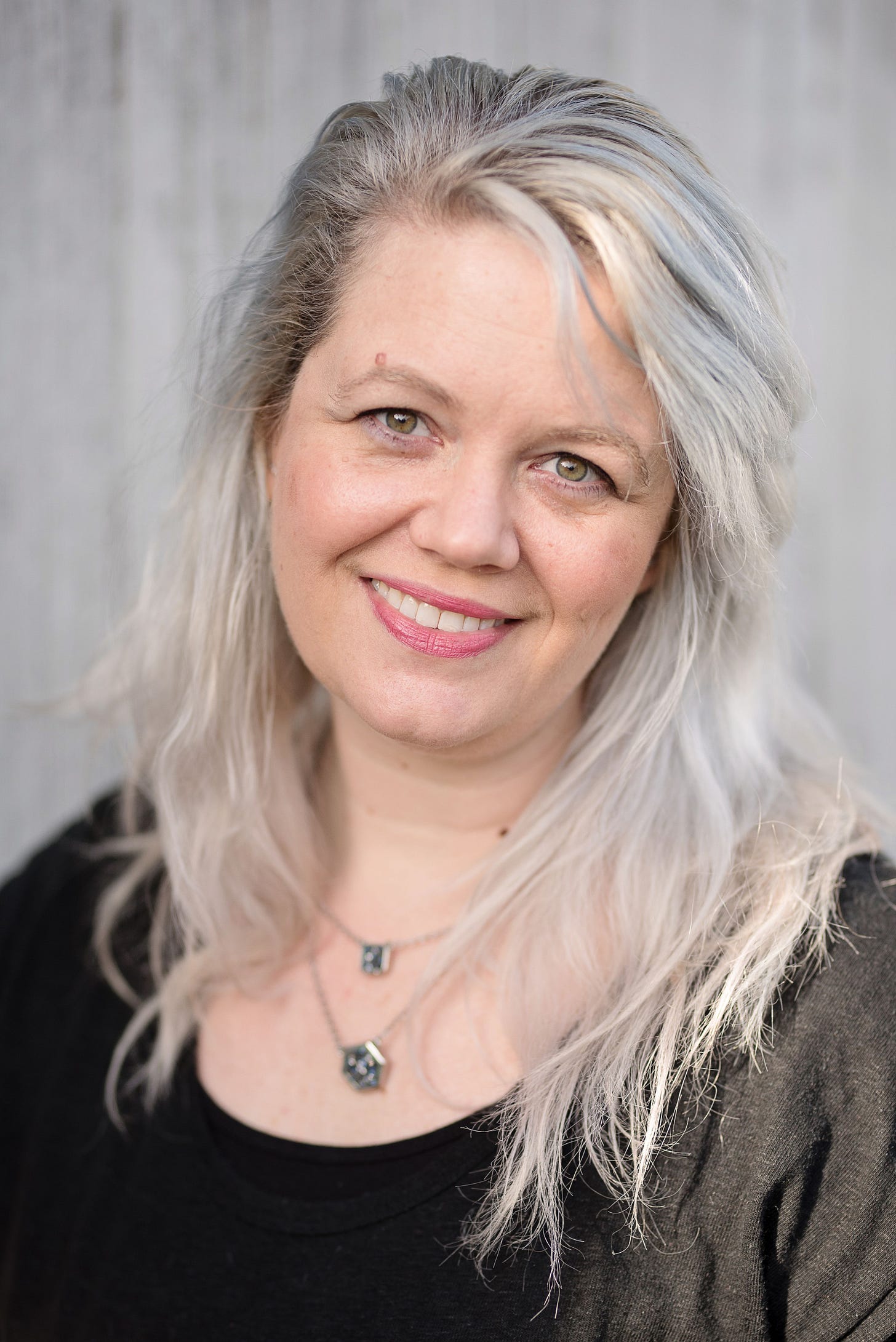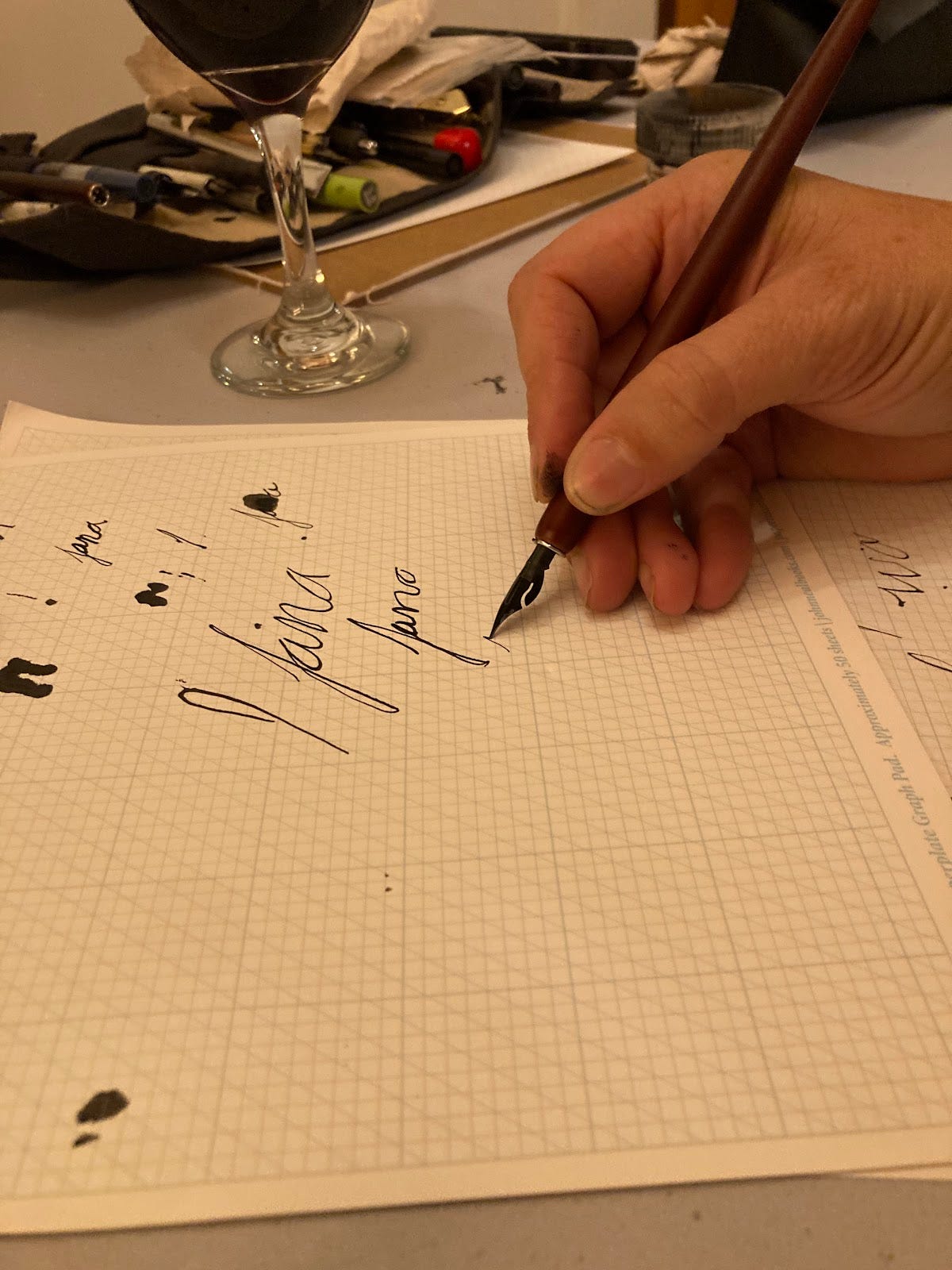Let Me Count the Ways
Guest writer, Jana, faces a long list of failures...and sees something new.
Hi, it’s me.
Today I drove my car onto a boat and ferried to an island. This never gets old.1 The pacific northwest is a magical place, and I can’t imagine living anywhere else.


Helping me out with the newsletter this week while I’m in my second of three consecutive travel weekends, is my friend Jana, a dear friend to Bryan and I for… I don’t know… a decade?
Jana has a creative, artistic, caregiving soul, and I connected deeply with her words, today. I recently experienced a rejection, which heaped defeat upon defeat. “I’ll never be good enough,” was my general disposition for a few days. It still stings, I still doubt, but I’m finding reasons to laugh again and move on to the next thing.
Maybe Jana’s words resonate with you? See you in the comments!
Let Me Count the Ways
by Jana Gering
Last month I discovered that I’ve been holding a pencil wrong for most of my life.
I am 44 years old, and I’m a visual artist. A multidisciplinary painter, I work in acrylic, watercolor, encaustic, cold wax, and more. Straight drawing, however, is always something I’ve struggled with, and I didn’t know why.
A few vague memories come to mind of an elementary teacher working with me on my pencil grip, trying to get me to drop my middle finger down and hold the pencil against the knuckle of my middle finger (correct, also known as a tripod grip) instead of using the pad of my middle finger to press against the barrel of the pencil next to my index finger (incorrect, now known to me as “unnecessary control grip,” which is kind of a metaphor for life).
The teacher must have given up at some point or, possibly, I followed a coping protocol of pretending like I got it and going along with her instruction until she stopped watching, at which point I would with relief switch back to my instinctual, but nonetheless incorrect, grip.
Who knows how this mistake began, really. It’s possible that being a right-handed child of two left-handed parents, I couldn’t get as much early mirror-training with handwriting. I only found out I’ve been holding a pencil wrong for almost four decades a couple of weeks ago by taking a calligraphy workshop with David Chang.
Two hours learning calligraphy techniques wasn’t nearly enough to overcome my decades of self-consciousness about handwriting, but I did find, through the gentle correction of David nearly every time I picked up a pen, that I’ve been holding pens and pencils incorrectly for a looong time.
At first, this felt like another thing to add to my list of failures and inadequacies, which currently feels pretty extensive. When I talked with Jen about what I might write about for a guest post, I half-jokingly suggested a theme of “how many ways can you feel like a failure and still keep going?”
“I love it” she texted back.
My first draft pivoted on an exhaustive list of all of my failures. I was seeking vulnerability, but perhaps unsurprisingly to those of you wiser than I am, no list of failures felt NOT self-pitying.
When I saw my failures listed in plain print, I started to realize that they didn’t look exactly like failures.
Some are just facts (I am unmarried. I don’t have children. My life as a single woman is not what I wanted. I am living with my parents as a 44-year-old).
Some are choices (I haven’t found full-time work in line with my skills, talents, purpose in life for a few years, I’m cobbling together income from gigs).
Some are actually injuries or traumas I am in the process of surviving or healing from –I hope (I lost my last full-time job in a hurtful way, just before a global pandemic, betrayals of leadership, friendship, dissatisfaction with the results of my own work).
The list of failures, when played on a loop in my brain, is easy to accept as very realistic, logical and true–these are the reasons I’m a failure. Obviously. Anyone could see it. But on the computer screen, the list of Very Real Failures I have taken ownership of loses some of its credibility. Staring at the list in stark Arial font in my Google doc, I wonder if maybe the things I believe to be barriers, failures, disasters, or regrets are activating so much Shame, when Sorrow, Anger, maybe Desire, Gratefulness, or even Joy might need at least some breathing room in the story, too.
In any case, I arrived at the class ready to learn a bit of pen-and-ink calligraphy from David, and lo and behold, I stumbled right into a new awareness of a failure I had been unknowingly perpetuating for forty-odd years.
David corrects my grip frequently, turning the nib to the correct angle. He notes that my middle fingertip is in the wrong place, and shows me the correct grip several times. We laugh about the technique being “all in the middle finger.” He teaches us to feel the way the pen tip moves on the paper when it’s correctly transferring the ink. We write rows of letters over stencil-printed templates to get used to the way the ink, angle, and connections between letters work. The word “minimum” is especially fun to practice–try it.
The thing about making art an essential part of my life is that it might have uniquely equipped me to deal with a life marked by failures. A practice of art-making means I will regularly run across skills I do not have, techniques I have to learn and relearn, muscle memory that needs repetition, discipline, practice. Things I make will look wrong and I’ll have to fix them, paint will drip in the wrong place, I’ll ruin clothes, carpets, printers, finished artwork that was innocently sitting too close to an active project.
The only thing an artist is guaranteed, practically, is failure.

How do I handle my failure to learn the basic human skill of holding a pen properly for most of my life?
The part of me that always keeps a list of Very Important Failures going in my brain is tempted to add it to that list, and move straight to the why-spiral stage of processing: Why didn’t I listen? Was I too stupid or too stubborn to understand when my 2nd grade teacher tried to train that mistake away? What was wrong with me that the wrong grip felt correct, when the correct one felt wrong? Has drawing and handwriting been so difficult all my life because of this single mistake, perpetuated over decades? I can’t get those years back! Is it too late to change now?
The why-spiral is supremely unhelpful. There’s no action in it, but I can’t give up writing things down altogether. In the months since the workshop, picking up a pen or pencil every time now is an exercise in awareness. Sometimes, when I begin writing or drawing out of habit, I catch myself holding the pen the old way, with that middle fingertip exerting undue control. It is work to do it the right way, to unpick the rusted locks of habit. It is a conscious action to write the correct way, and it feels unnatural.
I am relearning something as basic and essential as writing my letters! It feels a little foolish, but it also feels like an act of hope–and it all started with awareness of failure, giving me a little annoying hint that failure might just be a beginning as much as an ending.
I am a failure. I am faithful. I am learning. I am writing this letter–now this one–the right way, holding my pen in the uncomfortable correct grip. And the next. And the next. I’ll still go back to the old way out of habit, I’m sure. But I’m interested enough to keep wondering how this awareness of failure and intentionally learning a new way changes me.
I do this for fun, though, not for commuting.










Such a fabulous read! I found this part fascinating: "It’s possible that being a right-handed child of two left-handed parents, I couldn’t get as much early mirror-training with handwriting."
My husband is the right-handed offspring of left-handed parents, and he's the most left-biased right-hander I have ever met - he's not ambidextrous in his writing, but doesn't really seem to mind which hand he uses for most other tasks. However, he always wields a spoon left-handed - and he ties his tie as a left-hander, because his dad had taught him. 😍
I'm left-handed and find myself having to 'translate' right to left whenever I'm learning anything new. When I was teaching my craft I would make a point to demonstrate both right- and left-handed, because I remember when I'd first learned I'd had to work it out for myself. I'd been the only leftie in a class of right-handers with a right-handed instructor, and didn't want anyone to be in that position under my instruction!
I loved reading this. The photo of Jana is also so beautiful. I stopped and stared (In the least creepy way haha!) Just beautiful! Also can relate to the pencil grip. I can't do it any other way haha!